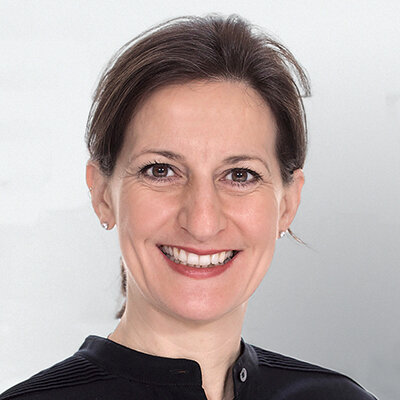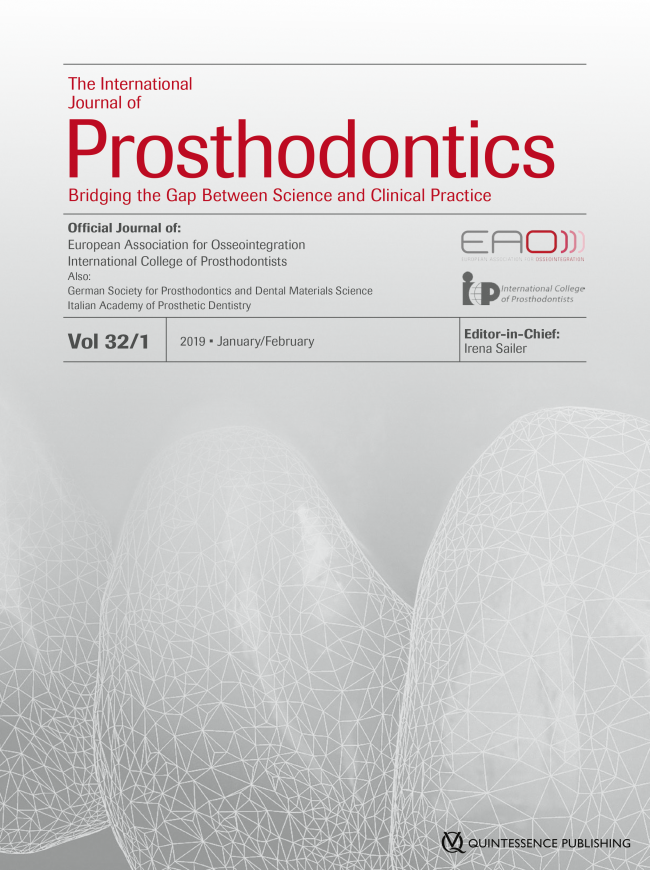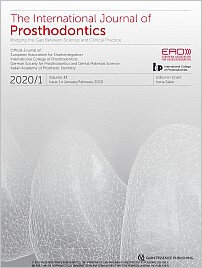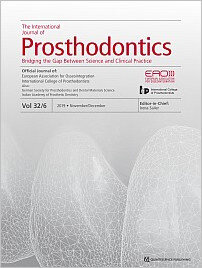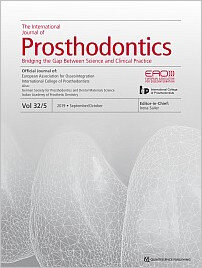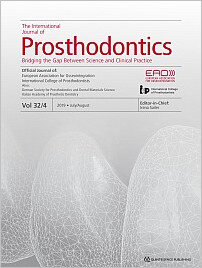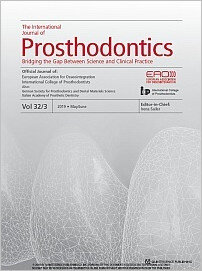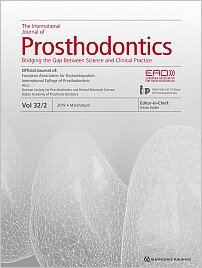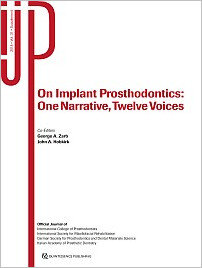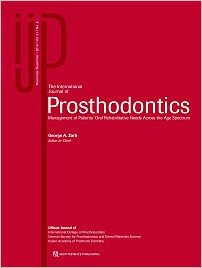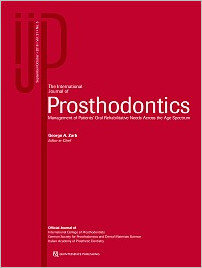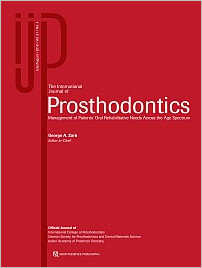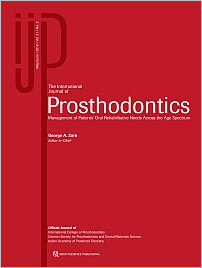Pages 5, Language: EnglishSailer, IrenaPages 6, Language: EnglishPages 7-8, Language: EnglishCongratulations to the winners of the Mario Martignoni Award! Quintessence is happy to present the first, second, and third place abstracts awarded this prize by the AIOP.
DOI: 10.11607/ijp.6223, PubMed ID (PMID): 31860908Pages 9-13, Language: EnglishRehm, Daniela D. S. / Progiante, Patrícia S. / Pattussi, Marcos P. / Pellizzer, Eduardo P. / Grossi, Patrícia K. / Grossi, Márcio L.Purpose: To verify the prevalence of sleep disorders in temporomandibular disorders (TMD) subjects in a Brazilian population-based, cross-sectional survey (N = 1,643).
Materials and Methods: Patients were assessed with the Research Diagnostic Criteria for TMD (RDC/TMD) Axes I and II and the Sleep Assessment Questionnaire. Student t test and Pearson chi-square test were used for continuous and categorical data analyses, respectively.
Results: TMD subjects had significantly worse sleep disorders than controls (Graded Chronic Pain Severity categories I through IV vs 0, respectively) in RDC/TMD Axis II variables. Sleep disorders were also worse in the Axis I TMD groups (myofascial pain and arthralgia/osteoarthritis/osteoarthrosis), with the exception of disc displacements.
Conclusion: TMD subjects had worse sleep disorders, mainly in Axis I TMD groups, with higher pain/disability levels.
DOI: 10.11607/ijp.6465, PubMed ID (PMID): 31860909Pages 14-21, Language: EnglishLiebermann, Anja / Erdelt, Kurt / Brix, Oliver / Edelhoff, DanielPurpose: To evaluate the survival and complication rates of full veneer restorations after up to 11 years of clinical service.
Materials and Methods: Six patients (four men, two women, median age 42.3 ± 4.7 years) were restored with a total of 40 adhesively luted anterior full veneers (maxilla: 36; mandible: 6; mostly canine to canine) made of lithium disilicate ceramic. Patients were treated between July 2007 and January 2014. All restorations were examined during annual recall visits using the modified United States Public Health Service criteria for color match, marginal discoloration, secondary caries, marginal integrity, surface texture, and restoration fracture, rated as Alpha, Bravo, or Charlie. Data were statistically analyzed using Kaplan-Meier estimation with log-rank test.
Results: Time of clinical service was 68 to 139 months (median: 8.1 ± 2.0 years) without any dropouts. Full veneer restorations in the anterior dentition presented a survival rate of 100% and a complication rate of 12.5% due to reparable minor chippings (technical complication/restoration fracture rated Bravo) of four restorations (one after 11 months, one after 20 months, and two after 66 months) and a crack in one restoration (after 38 months) due to trauma. No further technical (debonding or discoloration) or biologic (secondary caries) complications occurred.
Conclusion: Based on the present results, minimally invasive anterior full veneer restorations might be considered as a reliable treatment option, but further clinical data are essential.
DOI: 10.11607/ijp.6356, PubMed ID (PMID): 31860910Pages 22-28, Language: EnglishXiao, Weixiong / Chen, Chenfeng / Yang, Tao / Zhu, ZhiminPurpose: To evaluate the clinical performance of endodontically treated (ET) teeth restored with two different marginal forms of lithium disilicate glass-ceramic (LDG ceramic) onlays.
Materials and Methods: A total of 120 posterior teeth were prepared for onlays after ET. The occlusal surfaces of the teeth were removed 1.5 to 2 mm anatomically. Different marginal forms were employed depending on the thickness of the residual axis wall of each tooth: In Group S, a 1-mm shoulder was prepared when the remaining axis wall was > 2 mm (n = 50), and in Group B, a 20- to 30-degree bevel was prepared when the remaining axis wall was ≤ 2 mm (n = 70). The access of the pulp chamber was filled with resin, and 1.5 to 2 mm of the box morphology of the pulp chamber was preserved. The pressed LDG ceramic was applied to the fabricated onlays. The teeth and restorations were checked after 6, 12, and 24 months. All available restored teeth were assessed using modified United States Public Health Service criteria.
Results: During the observation period, no tooth fracture occurred. Neither tooth cracks nor secondary caries were observed in Group S or Group B. The 2-year survival rate of the teeth was 100%. Five fractured onlays were observed in Group S in the molar region, while all onlays in Group B were intact (P .05). The survival rate of the onlays was 95.83%.
Conclusion: The results demonstrate that LDG ceramic onlays can preserve ET posterior teeth with a highly satisfactory outcome, though the marginal form may affect the survival rate of the onlay.
DOI: 10.11607/ijp.6205, PubMed ID (PMID): 31860911Pages 29-38, Language: EnglishBittner, Nurit / Schulze-Späte, Ulrike / Cleber, Silva / Da Silva, John D. / Kim, David M. / Tarnow, Dennis / Ishikawa-Nagai, Shigemi / Gil, Mindy S.Purpose: To compare the optical effects of an immediately placed anodized pink-neck implant and abutment vs a conventional gray implant and abutment in relation to soft tissue thickness 6 months after the restoration was completed.
Materials and Methods: Forty patients with a hopeless maxillary anterior tooth received an immediate implant and an immediate provisional or custom healing abutment after flapless extraction. Participants were randomized to receive either a conventional titanium implant (control) or a pink-neck implant (test). All patients then received two identical CAD/CAM titanium abutments (one conventional gray, delivered first, and one anodized to appear pink, delivered 3 weeks after) and a zirconia crown. A spectrophotometer was used to record the color of the peri-implant mucosa and gingiva 3 weeks after delivery of each abutment and 6 months after the final restoration was delivered. The color difference between the two sites was calculated (ΔL*, Δa*, Δb*), and correlations with soft tissue thickness, change in ridge dimension, and implant position were assessed.
Results: Irrespective of the randomization group, changing the abutments from gray to pink showed a change in color between the peri-implant mucosa and the natural gingiva. Patients with a thin gingival biotype showed a statistically significant color change (P = .00089) in the a* axis, meaning that the gingiva appeared more pink (Δa*). No significant correlation between the soft tissue color and buccolingual collapse, vertical recession, or implant position was observed in either group.
Conclusion: The difference in color observed between the peri-implant mucosa and the gingiva was considerable in all groups. Anodized pink implants and abutments could reduce the difference in the red aspect (Δa*) of the peri-implant mucosa compared to the adjacent gingiva in patients with a thin biotype.
DOI: 10.11607/ijp.6393, PubMed ID (PMID): 31860912Pages 39-47, Language: EnglishPitta, João / Zarauz, Cristina / Pjetursson, Bjarni / Sailer, Irena / Liu, Xinran / Pradies, GuillermoPurpose: To systematically review the current literature on the influence of abutment material (metal vs ceramic) and soft tissue thickness on peri-implant soft tissue discoloration in partially edentulous patients restored with implant-supported single crowns. Methods: An electronic MEDLINE search was performed to identify randomized controlled clinical trials (RCTs) up to and including March 2017. The search was complemented by a manual search of related bibliographies. Selection of studies was made independently by two reviewers based on the inclusion criteria. Spectrophotometric data (ΔE values) and soft tissue thickness values were extracted, and, whenever applicable, a meta-analysis using a random-effects approach was performed.
Results: The search resulted in 208 titles and 30 abstracts. Full-text analysis was performed for 13 articles, resulting in 6 included RCTs. Meta-analysis of a total of 266 abutments revealed significantly lower ΔE values for ceramic abutments when compared to the overall metal abutments (z test value = 1.99, P = .05), with a mean difference of 1.41 (95% CI 0.02, 2.80). Nonsignificant differences were found between titanium and zirconia (z test value = 1.59, P = .11). Limited information on the correlation between soft tissue thickness and ΔE values was found. Hence, it was not possible to perform a meta-analysis of this question.
Conclusion: The color outcome of the peri-implant soft tissue might be influenced by the abutment material. Ceramic abutments appear to provide an improved color matching between peri-implant soft tissues and soft tissues around natural teeth when compared to metallic abutments. These findings support the preference for all-ceramic or "white" abutments in esthetically demanding cases.
DOI: 10.11607/ijp.6372, PubMed ID (PMID): 31860913Pages 48-55, Language: EnglishAshy, Linah M. / Marghalani, Hanadi / Silikas, NikolaosPurpose: To investigate the marginal and internal adaptations of ceramic inlay restorations placed with immediate dentin sealing (IDS) vs delayed dentin sealing (DDS) procedures.
Materials and Methods: Mesial and distal Class II cavities were prepared in 12 extracted molar teeth, which were randomly allocated into six groups of 2 teeth each. Lava Ultimate inlays were fabricated and luted to the cavities using All-Bond universal adhesive system and eCEMENT dual-curing resin cement following IDS/immediate cementation (control groups 1 and 2), IDS/delayed cementation (groups 3 and 4), or DDS/delayed cementation (groups 5 and 6) protocols. Teeth in groups 2, 4, and 6 were subjected to thermocycling of 500 cycles between 5°C and 55°C after inlay cementation. Following staining with silver nitrate solution, the marginal and internal gap volumes were determined using microcomputed tomography images. Statistical analyses were conducted using independent t test and one-way analysis of variance followed by Tukey post hoc test (P .05).
Results: Marginal gap volume for DDS (1.856 ± 0.323 mm3) was significantly higher than that of IDS immediately after inlay cementation (0.891 ± 0.281 mm3) (P = .025). Following thermocycling, the internal gap volume for DDS (0.838 ± 0.248 mm3) was significantly higher than that for IDS (0.098 ± 0.066 mm3) (P = .000), but the marginal gap volume of DDS (1.964 ± 0.956 mm3) was not significantly different from that of IDS (1.426 ± 0.725 mm3) (P = .622).
Conclusion: Luted ceramic inlays have a superior marginal adaptation right after cementation and a superior internal adaptation after thermocycling when using the IDS technique compared to the DDS technique. However, marginal adaptation after thermocycling was not significantly different between the two techniques.
DOI: 10.11607/ijp.6272, PubMed ID (PMID): 31860914Pages 56-62, Language: EnglishHaghi, Hamidreza Rajati / Shiehzadeh, Masoud / Gharechahi, Jafar / Nodehi, Davood / Karazhian, AsadPurpose: To compare the bond strengths of three types of permanent silicone and acrylic resin soft liners to the denture-base acrylic resin by employing both synchronous and asynchronous processing methods and different surface treatments.
Materials and Methods: A total of 198 cylindrical samples were fabricated from denture-base acrylic resin and a 3-mm soft liner. Surface treatments of the samples were classified into five groups (n = 33 each): no treatment (control); erbium:yttrium-aluminum-garnet (Er:YAG) laser; grit-blasting with 150-μm particles; monomer application; and phosphoric acid application. In addition, synchronous processing (n = 33) of the acrylic resin denture base and the soft liner was performed. Each group was divided into three subgroups (n = 11 each) based on the type of soft liner: Group M (Molloplast-B [silicone]), Group P (PermaFlex [silicone]), and Group A (AcroSoft [acrylic resin]). The samples were processed and thermocycled for 5,000 cycles between 5°C and 55°C, and the tensile strength test was then performed. The maximum tensile strength to failure and the type of failure were recorded, and Dunn statistical analysis and Kruskal-Wallis tests were used for comparison of the groups. The surface treatments were assessed using scanning electron microscopy.
Results: Irrespective of the method of processing or surface treatment, Group A had a significantly higher bond strength (8.1 ± 1.1 MPa) than the other two soft liners (Group M: 1.9 ± 0.3 MPa, Group P: 1.1 ± 0.2 MPa; P .001). Moreover, in Group A, the synchronous processing method produced a significantly higher tensile strength (P .001), while in Group P (P = .112) and Group M (P = .993), synchronous processing had no significant effect on bond strength. Bond strength after surface treatment in Group M was lowest after grit blasting (0.7 ± 0.2 MPa) and highest after monomer application (3.1 ± 0.5 MPa) (P .001). The same was observed for Group P in grit blasting (0.5 ± 0.2 MPa) and monomer application (2.1 ± 0.3 MPa) (P .001). For Group A, grit blasting (4.8 ± 0.7 MPa) was also the lowest and the monomer application (8.1 ± 0.8 MPa) the highest (P .001), while the bond strength resulting from the synchronous processing method was higher than that of the other methods (14.7 ± 2.1 MPa).
Conclusion: Within the limitations of this in vitro study, the acrylic resin soft liner showed the best bond strength. In all types of soft liners, surface treatment with the monomer resulted in higher bond strengths. Synchronous processing exhibited a significantly higher bond strength for the acrylic resin soft liner, but not for the silicone soft liners.
DOI: 10.11607/ijp.6435, PubMed ID (PMID): 31860915Pages 63-73, Language: EnglishXinran, Liu / Fehmer, Vincent / Sailer, Irena / Mojon, Philippe / Liu, Feng / Pjetursson, Bjarni ElvarPurpose: To evaluate the influence of different cements on the color outcomes of CAD/CAM lithium-disilicate implant crowns cemented to titanium-base abutments utilizing spectrophotometric analysis. Materials and Methods: A clinical situation with a missing lateral incisor was mimicked using a maxillary plastic model. Titaniumbase- supported monolithic lithium disilicate crowns with identical designs were fabricated using a laboratory CAD/ CAM system. The crowns were cemented with three provisional cements and with six definitive cements on both nonsandblasted and sandblasted titanium-base abutments for a total of 15 test groups. As a control group, identical crowns were attached with try-in paste on composite die abutments that duplicated the shape of the titanium-base abutments. The colors of the labial surfaces of the crowns and the peri-implant artificial soft tissue were measured with a spectrophotometer and recorded in CIE L*a*b* parameters. Color differences between the test and control groups were calculated as: ΔE = ([ΔL*]2 + [Δa*]2 + [Δb*]2)1/2. Kruskal-Wallis test was used to compare ΔE values across different groups. Results: The median ΔE values reported for crowns cemented with different definitive cements on titanium-base abutments ranged from 1.4 to 2.9 for the crown surface and from 1.7 to 1.9 on the peri-implant artificial soft tissue; when the titanium-base abutments were sandblasted, the respective median ΔE values ranged from 0.8 to 4.0 and from 1.4 to 2.2. Ceramic crowns cemented with Multilink HO 0 cement presented significantly (P < .01) lower ΔE values than the other cement types for the crown surface independent of sandblasting and for the artificial soft tissue surface when the titanium abutments were sandblasted (P = .011). Conclusion: Within the limitations of this study, Multilink HO 0 (Ivoclar Vivadent) cement showed the most favorable masking ability and the most favorable color outcome among the evaluated definitive cements. Cements of more opaque shades appeared in general to be more favorable in terms of masking the gray color of the titanium-base abutments.
DOI: 10.11607/ijp.6445, PubMed ID (PMID): 31860916Pages 74-80, Language: EnglishSanches Mariotto, Lígia Gabrielle / Valente, Mariana Lima da Costa / Castro, Denise Tornavoi de / Reis, Andréa Cândido dosAims: To evaluate the effects of different cleansing solutions on the physical-mechanical properties (roughness, surface hardness, and fatigue resistance) of three polymeric materials used to manufacture retentive attachments for overdentures.
Materials and Methods: The roughness and surface hardness analyses each employed 150 specimens measuring Ø 9 mm × 2 mm in thickness (polyacetal, polytetrafluoroethylene [PTFE], and polyethylene terephthalate [PET]; n = 50 each). For fatigue resistance analysis, 180 retentive attachments measuring 4 mm × 3 mm in height (n = 60 each) were used. The properties were evaluated before and after immersion in different cleansing solutions: distilled water, alkaline peroxide, 0.5% sodium hypochlorite (NaOCl), and Listerine. After the data distribution was verified using Shapiro-Wilk test, parametric or nonparametric analysis was applied (α = .05).
Results: The use of NaOCl caused a significant alteration in the roughness of the materials (P = .011), with a reduction in roughness in polyacetal and an increase in PTFE. The type of solution also influenced the surface hardness (P = .036); with the exception of distilled water, the other solutions promoted increased hardness. During the 24-month period, immersion in water, peroxide, and NaOCl (0.5%) caused increased fatigue resistance (P .05) of the PET attachments. The immersion protocol resulted in greater fatigue resistance (P .05) in polyacetal, while PTFE was not affected (P > .05).
Conclusion: Regarding the physical-mechanical properties evaluated, the polymers PET, polyacetal, and PTFE were susceptible to cleansing solutions.
DOI: 10.11607/ijp.6247, PubMed ID (PMID): 31860917Pages 81-90, Language: EnglishElias, Douglas Máximo / Valerio, Claudia Scigliano / Oliveira, Dauro Douglas de / Manzi, Flávio Ricardo / Zenóbio, Elton Gonçalves / Seraidarian, Paulo IsaíasPurpose: To apply finite element analysis (FEA) to investigate the stress distribution in a 4-mm-high ultrashort implant when supporting crowns of different heights in order to test the possibility of using this implant unitarily in the posterior edentulous mandible.
Materials and Methods: Three models of atrophic mandibles were created (M1, M2, and M3). Each model contained a 4-mm-length implant of a titaniumzirconium alloy, screw-type with internal connection, supporting nonsplinted screwed-in crowns of 10, 12.5, and 15 mm in height. Axial and oblique loads were simulated in the three model crowns.
Results: In an oblique load, the stress tended to be concentrated in the lingual region. In the qualitative results of the axial load, peaks of tension occurred in the lower angle between the inner groove and the inner conical portion of the implant. Regarding the differences in crown height, the 15-mm height produced a higher stress peak due to the lever effect of the crown under an oblique load.
Conclusion: Within the limits of this study, the results suggest the possibility of using single crowns of proposed heights with unitary ultrashort implants installed in the posterior edentulous mandible, so long as there is no oblique load on the crown.
DOI: 10.11607/ijp.6313, PubMed ID (PMID): 31860918Pages 91-98, Language: EnglishJafarian, Zahra / Moharrami, Mohammad / Sahebi, Majid / Alikhasi, MarziehPurpose: To compare the adaptation of conventional cast posts and cores to digitally milled counterparts in round and oval-shaped canals and to evaluate the retention of the milled posts.
Materials and Methods: One cast post and one milled post were fabricated for each of the 26 selected teeth, which had either round or oval-shaped canals. The apical gap was evaluated with radiography, and coronal adaptation was evaluated by weighing the silicon wash trapped between the post and canal wall and also by comparing the volumes of the stereolithographic models. The milled posts were cemented with self-curing glass-ionomer, and the pullout test was performed to evaluate retention. A two-way analysis of variance and independent t test were used for statistical analyses, with α = .05.
Results: Conventional cast posts and cores revealed significantly higher coronal adaptation and less apical gap than the milled groups (P .001), irrespective of the type of canal. Within the milled groups, there was no significant difference between the coronal adaptation of posts in the round and oval canals. On the contrary, the apical gap of milled posts was the least in the round canals (P = .024). The pull-out test revealed no statistically significant difference between the milled posts in the round and oval canals (P = .0864).
Conclusion: Conventional cast posts and cores revealed significantly better adaptation compared to the milled group. However, the adequate adaptation of the milled posts to the coronal portions of the canals provided tolerable retention. Nevertheless, clinicians should be cautious with the application of the scan posts, particularly in oval canals, as they could result in a large apical gap.
DOI: 10.11607/ijp.6348, PubMed ID (PMID): 31860919Pages 99-104, Language: EnglishLi, Zheng / Wang, Shimin / Ye, Hongqiang / Lv, Longwei / Zhao, Xubin / Liu, Yunsong / Zhou, YongshengPurpose: To establish a complete digital workflow for the design and manufacture of sports mouthguards and to observe preliminary clinical effects.
Materials and Methods: Eighteen healthy participants were included in this study. The self-controlled method was applied, and all participants were provided with two types of mouthguards. Digital mouthguards were designed and milled using CAD/CAM with polyetheretherketone, and conventional mouthguards were fabricated using the vacuum pressure-forming method with ethylene vinyl acetate. The order of wearing was determined using a random number table, and the washout period between was set as 1 month. Degrees of satisfaction in terms of retention, appearance, occlusal comfort, and labial comfort were evaluated. Distribution of occlusal force was tested using the T-scan analysis system. Participants were also asked to choose one mouthguard for future use.
Results: The complete workflow of digitally designed and manufactured sports mouthguards was successfully established. No significant difference was noted in retention between the types of mouthguard. The appearance score (P = .025), occlusal comfort score (P = .030), and labial side comfort score (P = .003) of the digital mouthguard group were significantly higher compared to the conventional mouthguard group. T-scan analysis results showed that in centric occlusion, participants exhibited occlusal contact in the second molar alone while wearing conventional mouthguards, while the occlusal force was uniformly distributed with digital mouthguards. Sixteen participants selected the digital mouthguard for future use.
Conclusion: Digital design and manufacture of sports mouthguards improved the occlusal design and greatly simplified and optimized the conventional fabrication process.
DOI: 10.11607/ijp.6232, PubMed ID (PMID): 31860920Pages 105-110, Language: EnglishOliveira, Adriana / Felinto, Lázaro Teles / Francisconi-dos-Rios, Luciana Fávaro / Moi, Gisele Pedroso / Nahsan, Flavia Pardo SalataEnamel hypoplasia occurs because of a defect in formation of the organic matrix during the development of tooth enamel. Minimally invasive procedures of the slightly altered enamel contribute to a greater longevity of teeth and prevent them from relapsing into the repetitive restorative cycle. This case history report aimed to show a sequential technique of minimally invasive procedures for esthetic resolution in anterior teeth. Prior to microabrasion, anterior teeth were bleached in office with 37% hydrogen peroxide. Afterwards, hypoplastic spots on the buccal incisal thirds of the maxillary central incisors were treated with two sessions of microabrasion using phosphoric acid and pumice stone and one session using resin infiltrant. Besides a slight remaining white spot on tooth 21, the masking of spots was done with this sequence of treatments, re-establishing color harmony. Spot depth, diagnosis, and the most relevant treatment choice determined the clinical success.
DOI: 10.11607/ijp.6329, PubMed ID (PMID): 31860921Pages 111-115, Language: EnglishMorita, Koji / Tsuka, Hiroki / Kuremoto, Koi-chi / Tsuga, KazuhiroThe primary concern in carrying out dental implant treatment in patients with chronic myelogenous leukemia is the development of peri-implantitis. However, currently, the advent of molecular-targeted drugs such as nilotinib markedly improves the survival rates in such patients, and it is reported that remission status can be maintained for a long time without abnormalities such as a decrease in white blood cell count. This case history report discusses an 8-year follow-up of implant treatment administered during the remission phase of chronic myelogenous leukemia maintained using nilotinib. A 56-year-old male patient who was undergoing treatment for chronic myelogenous leukemia at the Department of Hematology requested a dental consultation for the treatment of a mastication disorder due to loss of mandibular left molars. After confirming via oral and radiographic examination that there were no abnormalities such as periodontal disease, temporomandibular joint symptoms, or metal allergy, two Brånemark System Mk III implants with diameters of 3.75 and 5 mm and lengths of 10 and 8.5 mm, respectively, were embedded in the defect. Following this, no problems were observed in the general condition, esthetics, or oral function around the implant. Further, symptoms such as mobility of the implant body or inflammation of the surrounding tissue have not appeared to this day, as the molecular-targeted drug decreases the occurrence of immunosuppression, which could not be achieved conventionally. Although this is only one instance, the possibility of implant treatment for chronic myelogenous leukemia patients in the remission phase has been presented in this case.
Pages 116-135, Language: EnglishSeptember 4-7, 2019 Amsterdam, the Netherlands 